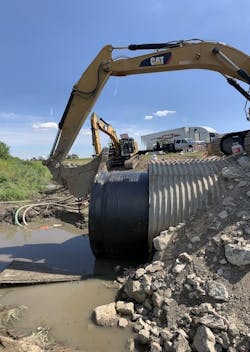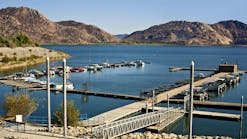About the author:
Erica Bender is a freelance writer and editor specializing in the architecture, engineering and construction industry. Bender can be reached at [email protected].
by Erica Bender
undefinedEducation is key to choosing a high-quality, cost-effective, long-lasting material for infrastructure piping systems. Moving beyond convention to take advantage of more innovative options can translate to significant benefits for contractors and project owners alike.
One solution worth considering is high-density polyethylene (HDPE), a flexible plastic material valued for its durability, versatility and longevity. Designed with sustainability and resiliency in mind, HDPE pipe is lauded by industry professionals worldwide for its corrosion and chemical resistance, weatherability, low maintenance, ease of installation and eco-friendliness.
HDPE pipe is utilized in a variety of sectors, including municipal, industrial, marine, mining and agricultural. In the U.S., it is most commonly used for conduits to transport natural gas, chemicals and potable water. However, a growing awareness of the product’s unique capabilities is gaining momentum in other national markets.
“In large-diameter pipe applications, such as highway construction and storm water/wastewater management, HDPE is becoming a go-to solution in many regions because it is proven to outperform traditional materials such as concrete, fiberglass and corrugated metal,” said Iris Jancik, vice president of business development and sales at Plasson USA, a subsidiary of Plasson Group. “The value-engineering advantages of HDPE pipe just make sense in today’s construction world.”
Designed for Innovation
For low-pressure applications, Plasson USA offers pipes up to 120 inches in diameter with its Spirolite pipe.
Most HDPE pipe manufacturers use heat fusion to create a fully monolithic system that is remarkably strong yet lightweight. This method also produces a leak-free system in terms of both infiltration and exfiltration, which makes the pipe more resilient against impacts caused by ground movement.
“Many non-HDPE products are prone to leakage and can cause the surrounding soil to erode from around the pipe. This, in turn, can lead to pipe instability and failure,” Jancik said.
To optimize strength, stiffness, toughness and long-term reliability, all Spirolite products are made from HDPE 4710 pressure-grade resin approved by both the American Water Works Association and the American National Standards Institute. Spirolite also features a reliable and robust bell-and-spigot gasketed system or a plain-end, fields-welded joint—both of which contribute to reduced installation time. Recently, Plasson USA developed a 50 psi pressure-rated system by incorporating specialized electrofusion technology into its Spirolite pipe design.
An Economical Choice for Culvert Rehab
For roadway improvement projects, an increasing number of state transportation agencies are choosing to reline damaged or deteriorating pipelines with Spirolite. This is in large part due to HDPE’s sustainable engineering, which provides a 100-year minimum lifecycle and offers a more permanent, economical solution versus repairing or replacing the structures.
The Indiana Department of Transportation (INDOT) is one organization that has utilized this to reline its highway culverts for a number of years. For example, in summer 2019, when a failing corrugated metal pipe (CMP) culvert beneath Interstate 65 threatened to collapse the road, INDOT had to act quickly to fix the situation.
“The corrugated metal had corroded over time due to a live-flowing creek that ran through it,” said Spirolite Products Group Business Leader Ken Thielbar. “The culvert was in such poor condition that there was no bottom to the pipe at all; it was basically just mud."
Thielbar added that HDPE pipe is a fast and cost-effective relining option because it is lightweight, flexible and tough, making it easy to push inside of a host pipe.
Working in partnership with the Snap-Tite division of ISCO Ind., a piping materials supplier based in Louisville, Kentucky, Plasson USA provided 280 feet of 120-inch-diameter Spirolite to reline the existing 144-inch-diameter CMP culvert.
“With certain other products, crews would have to continually perform bypass pumping because they need clean, dry conditions to perform any on-site pipe welding. But with HDPE pipe, workers can assemble the system in semi-wet conditions, so only minimal bypass pumping is needed,” Thielbar said.
He added, “For this project we supplied Spirolite pipe with a Manning’s ‘n’ value of .009, which allowed us to downsize from the 144-inch-diameter host pipe to a 120-inch Spirolite pipe and still offer superior flow characteristics. This made it the ideal choice when compared to other types of liners. Plus, HDPE’s hydraulic performance does not change or deteriorate as the pipe ages, as is common in other types of pipe.”
The location of the project also necessitated a speedy construction response.
“I-65 is a major four-lane highway near Lafayette, Indiana, that connects Chicago to Indianapolis,” Thielbar said. “The job had to be done without interrupting traffic, which could not be rerouted efficiently along this heavily traveled corridor.”
Temple & Temple Excavating & Paving Inc. of Salem, Indiana, installed the new carrier pipe using a trenchless rehabilitation method known as sliplining, which can be performed without blocking or rerouting traffic. In optimal conditions, the installation takes approximately one to two days, followed by grouting of the annular space, which supports the 100-year lifecycle solution mentioned previously. The sliplining approach not only minimizes negative traffic impacts but also enhances worker safety and saves the project team and owner time and money.
In addition, the product’s bell-and-spigot joint connections made the profile pipes easy to install with workers connecting each section to the previous one and then pushing the monolithic structure into the host pipe, under live flows.
Tough Enough for Harsh Environments
Whether it is under a busy highway, in areas of anticipated soil settlement or in highly corrosive environments, HDPE products are engineered for long-lasting performance.
Recently, Plasson teamed with Southeastern Pump, a water/wastewater pumping contractor, on a new development in Florida requiring approximately 250 new lift stations made of 39-inch-diameter HDPE. This ongoing job is for the Seacoast Utility Authority, which has a service area covering 65 square miles.
Ranging in height from 84 to 180 inches, the manholes are designed for wastewater transmission in a coastal environment with high levels of salinity. HDPE materials—which do not rust, decay, corrode or support bacterial growth—are ideally suited for this type of conveyance system and region.
According to Thielbar, the conventional materials used for lift stations include corrugated metal, fiberglass or concrete. Previously, the Seacoast Utility Authority had poor luck with fiberglass installations and turned to HDPE as a long-term solution, as it has twice the life span of concrete and higher resistance than certain materials to caustic sewer gases, soil expansion or shifts in soil caused by groundwater or seawater.
“These types of projects typically use fiberglass,” Thielbar said. “While fiberglass does have good anti-corrosive qualities, challenges arise if the material gets damaged, which can result in fracturing. Once the fiberglass becomes fractured, the hydrogen sulfide gases continually eat way the lining of the lift station and will consequentially cause the structure to yield or collapse over time.”
Other noteworthy characteristics of the HDPE lift stations include outstanding wall crush strength, constrained buckling resistance and deflection control. The resulting structures offer enhanced stability and safety for workers entering or exiting the confined spaces. In addition, the thermal-welded joints prevent the intrusion of groundwater and seawater as well as contamination of the environment by leaking sewage.
“We supply a completely sealed system, which reduces pumping and electrical costs for the developer,” Thielbar said.
Knowledge Is Key to Resiliency
Modernizing America’s infrastructure—which is buckling under decades of underinvestment as well as unprecedented population growth and economic demands—is a critical issue for private and public developers, municipalities, state and federal agencies, and legislators. By deepening an understanding of the advantages and applications of HDPE solutions, design and construction professionals can help take the pressure off key decision-makers by pointing them toward reliable, affordable, enduring solutions.






